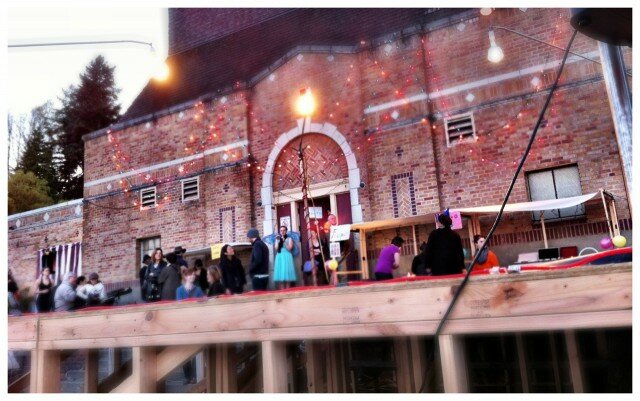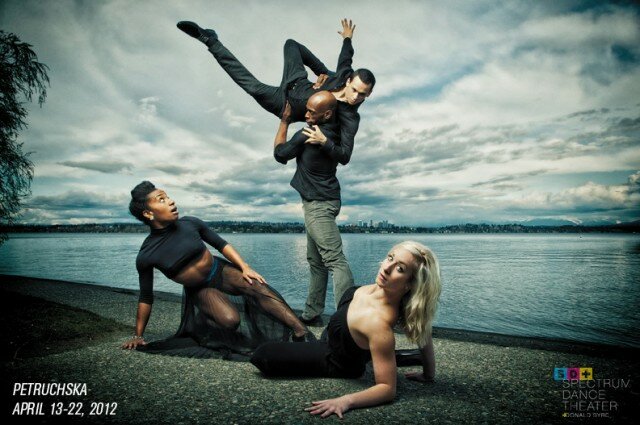Spectrum Dance Presents Petruchska as a Surreal Erotic Carnival
You have one last weekend to visit what feels like an instance of “On the Boards East,” as Spectrum Dance Theater presents choreographer Donald Byrd’s revisioning of his Petruchska (at SDT’s Lake Washington studio April 20 to 22; tickets: $25/$20 students). In fact, why not double down? At the actual On the Boards this weekend, you can see Kyle Abraham’s “Live! The Realest MC,” which also draws on puppet-based themes to delineate human experience.
Byrd’s Petruchska-this-time is as much art installation and “happening” as it is dance. The inimitable Byrd tricks you into taking your place, that, too late, you determine is a dunk tank’s seat, over a pool of eerie, erotic thrashings. There’s the pitch! Down you go, metaphorically.
It is emphatically “not for children,” though the evening begins innocently enough. You’re greeted by a backyard carnival–tickets a buck a pop–with ring tosses, popcorn, and Dante’s Inferno Dogs. It takes a few minutes–it feels at first like a modest fundraising opportunity–before you realize you’ve stepped into the fair indicated as opening Stravinsky’s original ballet. You can’t undo it; gone is the fourth wall. As you hand over your ticket, you accept a measure of culpability.
As Byrd blogged earlier, he’s become interested in stage directing his choreographic works, and for Petruchska, with the aid of a cavalcade of design talent (Greg Ashworth, video; Doris Black, costumes; Rico Chiarelli, lighting; Scott Colburn, sound; Matthew Richter, scenic; Isaac Waring, the carnival), he’s created three stages: the outdoor carnival, the usual dance studio upstairs, and a “surveillance room” on the main floor, that you move between on cue.
Donald Jones, Jr., in full huckster mode, appears first as the Charlatan, the puppet master/adult revue manager, exhorting the crowd to pay up to see “what’s inside,” offering a free look at some of his delightful ladies. Nothing quite goes right for him throughout the course of the evening: acts cancel, puppets misbehave (and so did a costume element on opening night, but he managed it one-footed). There’s a moment where he’s surrounded by dancers, they’re waist-bent as if in homage, petals to his stamen, and Jones grins broadly at all assembled–it’s epic in its falsity.
His private show is something less than promised, as well. When the “life-sized” puppets come to life, it’s as misshapen members of an asylum, moaning and muttering; most of this puppet troupe (Jeroboam Bozeman, Derek Crescenti, Jovian Fry, Amber Nicole Mayberry, Shadou Mintrone, Kate Monthy, Briley Neughbauer) are hung from straps, while the drama between Petruchska (Vincent Michael Lopez), Columbine (Jade Solomon Curtis), and the Moor (Ty Alexander Cheng) plays itself out.
You find yourself watching Byrd’s puppet choreography with amazement–how alien it seems, the dancers mimicking string pulls at wrist, elbow, knee. The strange, knees-out hop is spot on; they levitate. You can spot when one or two forget and move from their core.
It probably helps to know that, for Stravinsky, Petruchska turns to Columbine as a distracting relief from his puppet-istential angst. This isn’t that kind of love story, though it’s touching, even so. Lopez is terrific at conveying in vital pantomime the volatile twitchiness of the unloved, not quite sure how to ask for such a thing. Lopez is compressed, then startlingly grasping.
Curtis’s Columbine is, bluntly, hot–if you care to admit your thing for animate(d) puppets. These attractions are a two-edged wooden sword, though, as Petruchska discovers when Columbine is responsive to the Moor’s more predatory advances as well. To creep you out further, Byrd has the Moor-Columbine assignation play out on video, though you can hear the dancers pant, tumble, and grunt in the next room.
It’s a disquieting, voyeuristic glimpse of athletically rough sex, meant to put you in mind, I think, of internet fare and the misogynistic socioeconomic puppetry involved, as much as this particular love triangle. If you continue to dive down in search of signifiers, I’m not sure there’s a bottom. But that intrusion of disjunctive, live sound reminds you of the humanity of the performers, their vulnerability, even as Cheng, on all fours, springs at the bed; even as Curtis alternately tames and succumbs.
Petruchska cannot, of course, handle the Moor’s manhandling of Columbine; he attacks, to the Charlatan’s sputtering chagrin. You are led outside, where the action extends beyond the raised stage on the beach, to Spectrum’s roof–joggers on the beach crane their necks at this Fellini-esque irruption. So do you. Everything seems to be in play, and you’re without a safe word. Alive, dead, Petruchska shakes his fists at the Charlatan’s attempt to dehumanize him. But who did the Charlatan do that for? For you. Your amusement, your entertainment.
I more or less fled the scene.



 Daily Email Digest of The SunBreak
Daily Email Digest of The SunBreak